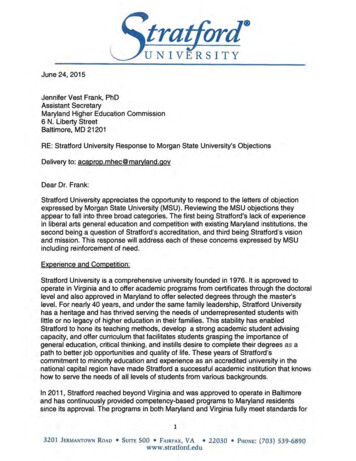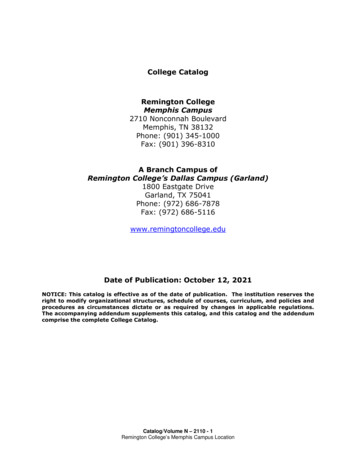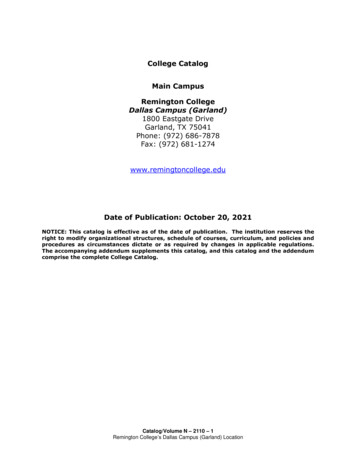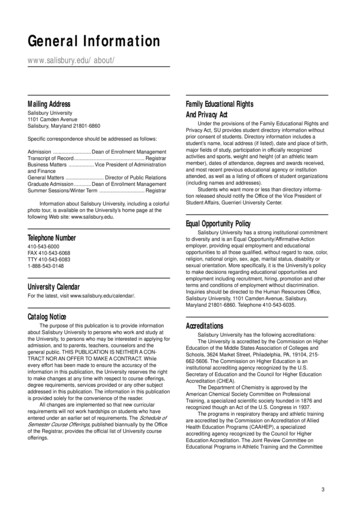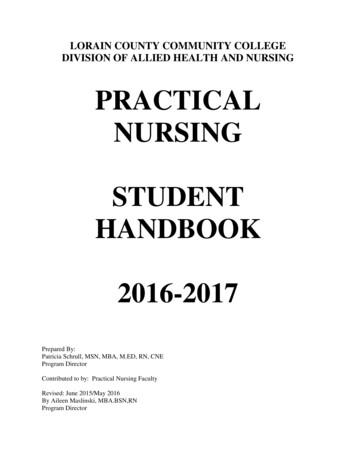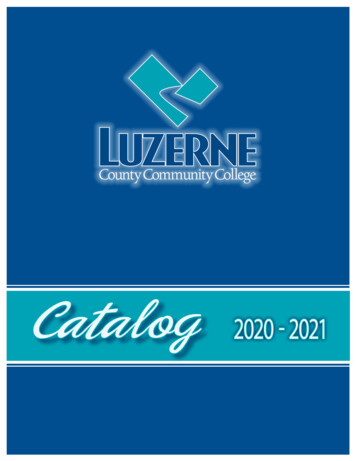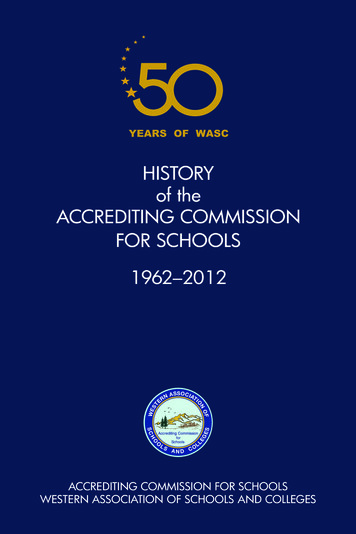
Transcription
HISTORYof theACCREDITING COMMISSIONFOR SCHOOLSERSSOCI ANATIOOFWENST1962–2012LSLEHOGESSCOOAND CLACCREDITING COMMISSION FOR SCHOOLSWESTERN ASSOCIATION OF SCHOOLS AND COLLEGES
HISTORYof theACCREDITING COMMISSIONFOR SCHOOLS1962–2012ACCREDITING COMMISSION FOR SCHOOLSWESTERN ASSOCIATION OF SCHOOLS AND COLLEGES
Accrediting Commission for SchoolsWestern Association of Schools and Colleges533 Airport Boulevard, Suite 200Burlingame, CA 94010www.acswasc.orgAll rights reserved. ACS WASC retains full copyright ownership, rights and protection of all materialcontained in this document. No part of this book may be reproduced or utilized in any form or by anymeans, electronic or mechanical, including photocopying, recording, or by any information storageand retrieval systems without permission in writing from ACS WASC. 2012 by ACS WASC. All rights reservedDesign and Production: Cynthia Newton Editing: Cynthia Newton and Sheléne Peterson
History of the Accrediting Commission for Schools, 1962‒2012CONTENTSCONTENTS . iFOREWARD . iiiTHE FIRST 25 YEARS: 1962–1987 . 1Lyle E. Siverson: 1975–1984 . 13Don E. Halverson: 1984–1992 . 19THE SECOND 25 YEARS: 1987–2012 . 23Don E. Halverson: 1984–1992 . 23Donald Haught: 1993–2002 . 25David E. Brown: 2003–present . 27Accrediting Commissions for Schools in Photographs . 35APPENDICESORIGINAL WASC CONSTITUTION, 1962 . 45ACS WASC EXECUTIVE DIRECTORS . 49ACS WASC COMMISSION CHAIRPERSONS . 49i
Western Association of Schools and Collegesii
History of the Accrediting Commission for Schools, 1962‒2012FOREWARDThe History of the Accrediting Commission for Schools, 1962–2012, wascreated to provide a brief summary of what now represents our “first 50years.” It is the result of expanding the work completed 25 years ago whenthe Accrediting Commission for Schools, Western Association of Schoolsand Colleges (ACS WASC) was completing its first twenty-five years ofoperation. Documenting the last twenty-five years of our institutional pastwas accomplished in part through the efforts of several contributors,including Dr. Don Halverson, and Dr. Donald Haught, former ACS WASCExecutive Directors, who have provided observations about their years ofservice.Growing from a small number of schools in 1962 to what now exceeds 4,500institutions for learning, ACS WASC is deeply grateful to all those who haveserved on the Commission, volunteers who have chaired and served onVisiting Committees, staff who work tirelessly in the Burlingame andTemecula offices, and the schools who have ultimately ensured through theirdedicated efforts that individual school self-studies effectively provideguidance and direction for improving the quality of our service to thestudents of the ACS WASC region.The book was skillfully compiled and edited by Cynthia Newton, who worksin the Burlingame Office. We thank her and all those who have contributedto the success of our organization over the last half century.Congratulations to all of you for the various roles you have played in trulymaking a difference. Here’s to another 50 years of continued growth andsuccess.David E. BrownExecutive DirectorAccrediting Commission for SchoolsWestern Association of Schools and CollegesJune 2012iii
Western Association of Schools and Collegesiv
History of the Accrediting Commission for Schools, 1962‒2012THE FIRST 25 YEARS: 1962–1987[The following pages are excerpts from the History of the WesternAssociation of Schools and Colleges 1962-1987, Lyle E. Siverson, April 10,1987, Western Association of Schools and Colleges, Oakland, California.]ACCREDITING COMMISSION FOR SCHOOLSOrganization: 1961The organizational meeting of the Accrediting Commission for SecondarySchools of the Western Association of Schools and Colleges was held onNovember 29, 1961, in Burlingame, California. The concept of a new,umbrella organization of schools and colleges had been approved and aSteering Committee of representatives from the various associations haddeveloped a proposed constitution. Prior to this November date, allassociations involved had given approval to this proposed document (SeeAppendix A), and each of the three commissions was in the process of beingestablished within the framework agreed upon by the parties concerned.Nine of the thirteen original members to be appointed to the SecondarySchools Commission were present (See Appendix D). Also present byspecial invitation was William N. McGowan, Executive Director of theCalifornia Association of Secondary School Administrators (CASSA), a manwho was the central figure in the development of the evaluation program forthe public high schools. The nine members present were appointees of thevarious secondary school groups which were coming together in the newAssociation. Though each association was made up of schools with differinggoals, they had at least two things in common. First, they had some type ofcertification or accreditation requirement for membership in their respectiveassociations. Second, their schools were “accredited” by the University ofCalifornia. For varying reasons and in widely differing degrees, there wasdissatisfaction with the mandated requirement that the University of Californiapublish an “accredited list of high schools.” Indeed, the University itself wasuncomfortable in the role of accrediting schools with neither adequateresources nor support to develop a comprehensive evaluation and visitationprogram. Being on the “accredited list” meant, in reality, that the high schoolwas offering courses of study which would lead to admission to theUniversity and that the first semester grades of graduates of that high schoolin attendance at the University had been generally acceptable.1
Western Association of Schools and CollegesHoward H. Pattee, Executive Secretary of the California Association ofIndependent Schools, had been extensively involved in the planning for thenew association. It was appropriate that he be the first appointee of CAIS tothe Secondary Schools Commission. His group was not particularly unhappywith “accreditation” by the University. It was, after all, an association of“college prep” schools organized in 1940 with standards formulated bya Board of Standards composed of representatives of leading colleges. Whenit became apparent that the University might take steps to discontinue itsaccreditation role, the independent schools were eager to become affiliatedwith a large, private association which would help to guard against what theyperceived to be an ever-present threat of increased State control by thelegislature or excessive interference by the Department of Education.John T. Foudy, Superintendent of Schools of the Archdiocese of San Francisco, and Joseph F. Sharpe, Superintendent of Schools of the Archdiocese ofLos Angeles, were the first members of the Commission to represent theWestern Catholic Education Association. They too had been activelyinvolved in the planning from the outset and had made significantcontributions in the evolving structure and policies of WASC. WCEA hadcome into being as a result of concern that the University of California woulddiscontinue its accreditation. As far back as 1940-48, when Bishop JamesO’Dowd was serving as Superintendent of Schools for the San FranciscoArchdiocese, he was predicting the withdrawal of UC from the business ofaccrediting and recommending the establishment of a regional accreditationassociation rather than the alternative — accreditation by the State. In 1957Msgr. Francis Quinn was assigned the task of organizing an association forthe accreditation of Catholic secondary schools, and the WCEA was formedby the California Bishops and the Diocesan School Superintendents. At thetime of the organizational meeting of the Schools Commission under WASC,104 Catholic high schools had been evaluated and visited by the WCEA.WCEA members were motivated to become a part of WASC because itrepresented a non-governmental, private agency that would help to insulatethem from State or Federal government controls. There was an additionalconcern, however. Just as they did not want to submit their schools to thecontrol of the State, neither did they want to turn over that control to aprivate agency which might adopt procedures and standards heavily skewedtoward the public schools. Early in the planning process Father Foudyexpressed this concern. In a five-page position paper at the December 12,1960, meeting of the Steering Committee, he cautioned that “any newaccrediting association for high schools must somehow be disassociated fromany particular school system or from a single philosophy of education.” Healso expressed doubt “that an evaluative instrument standardized on public2
History of the Accrediting Commission for Schools, 1962‒2012schools could be applied without modification to private schools.” Thisconcern found a receptive ear and was ultimately expressed in Article IV ofthe proposed Constitution: “The standards for accreditation shall clearlyguarantee that each individual institution is to be evaluated on the basis of thedegree to which it is accomplishing the purposes and functions outlined in itsown statement of objectives, and on the appropriateness of those functionsfor an institution of its type.”Representing the Seventh-day Adventist Schools as a member of the Commissionat its organizational meeting was Lowell Rasmussen, Secretary of theDepartment of Education Pacific Coast Conference of Seventh-dayAdventists. Going back as far as 1901, the Pacific Conference high schools hadgone through an evaluation/visitation and accreditation program at the nationallevel sponsored by the General Conference. Those high schools were also onthe University of California Accredited List. They were interested inmaintaining an affiliation with a private accrediting body as well as their ownchurch organization. Consequently, Dr. Rasmussen and other church officialshad participated actively in promoting the formation of a regional accreditingagency.The five additional members of the Commission present at the organizationalmeeting were representatives of the public high schools. All had beenactively involved in developing the evaluation/accreditation program forpublic high schools and in creating the Accrediting Commission for CASSA.They were: J. Wesley Berry, Principal of Modesto High School; Donovan E.Cartwright, Superintendent, Tulare Union High School District; Irwin A.Dann, Assistant Superintendent, Fresno City Schools, Hal W. Hamm,Superintendent, Santa Ynez Valley Union High School District; and WilliamBruce Kirkpatrick, Principal, John Marshall High School, Los Angeles.CASSA had been motivated to become involved with the evaluation/accreditation of high schools in the late forties and early fifties. This was thegroup with the greatest dissatisfaction regarding the University of CaliforniaAccredited List. High school administrators found it inconsistent, evenrepugnant, that the same State laws which required them to enroll and meet theneeds of all students as a comprehensive high school would mandate thatthose schools be “accredited” solely on the basis of meeting the needs of anextremely small sample of “college prep” students who represented only onesegment of the public high school to the exclusion of its responsibilities toother students.Committees were established to examine the various evaluation instrumentswhich were in use at the time. The Evaluative Criteria were tested in severalhigh schools in the early fifties but they were regarded as too quantitative in3
Western Association of Schools and Collegestheir approach. In the late fifties a format was developed based on qualitativelyoriented procedures that were originally formulated by William McGowan asa part of his doctoral studies at Stanford University. After being tested inseveral schools and after several revisions, “Procedures for Appraising theModern High School” became the basic instrument used by CASSA in itsevaluation program.In 1957 legislation was approved making it possible for school districts to payfor the costs of accreditation. CASSA formed an Accreditation Committeein 1958. By 1962 when it became a part of WASC, 482 public high schoolshad entered the program.The nine men, representing four separately identified constituencies,assembled at 9:30 a.m. on November 29, 1961, to organize the WASCAccrediting Commission for Secondary Schools. After agreeing thatDonovan Cartwright serve as Acting Chairman, the group invited WilliamMcGowan to join them. There was consensus that they should remove theword “proposed” from their copies of the WASC Constitution since it wasreported that each organization had officially approved it. J. Wesley Berry waselected to serve as the first Chairman of the Accrediting Commission forSecondary Schools. Appointed to represent the Commission on the Board ofDirectors were J. Wesley Berry, Father John T. Foudy and Erwin Dann. HowardH. Pattee was designated as the Commission representative on the JuniorCollege Commission. Hal W. Hamm was appointed as the Commissionrepresentative to the Senior College Commission.L. W. Hedge, Principal of Bakersfield High School was designated as theExecutive Director. Mr. Hedge was admirably qualified for the position sincehe had been Chairman of the initial CASSA Accrediting Committee formedin 1957 to offer accreditation to public high schools. Furthermore, he had beenone of the key persons in negotiating with representatives of other groups toform a new Regional Accrediting Association.The minutes of the meeting indicate that four members of the originalthirteen-member Commission were absent from the organizational meeting.They were: Everett O’Rourke, the first representative of the California StateSuperintendent of Schools; F. Melvyn Lawson, Superintendent, SantaMonica City Schools; Gilbert Collyer, President of Shasta Junior College,representing the Junior College Commission; and Charles S. Casassa, SJ.,President of Loyola University, representing the College Commission.4
History of the Accrediting Commission for Schools, 1962‒2012WASC: 1962On January 24, 1962, the Western Association of Schools and Colleges wasofficially incorporated in a meeting attended by the three representativesdesignated by the Commission. The Board decided to give tentative approvalto the criteria and procedures for accreditation by the three Commissionssubject to final approval at a subsequent meeting at which completedocuments would be submitted. On behalf of the Secondary Commission,Mr. Berry reported that it would be employing the several sets of criteria thenbeing used by CASSA, WCEA, CAIS, and the Seventh-day Adventists withthe intention that some common set of criteria, with sub-divisions for thedifferent categories of schools, would be developed later.A second item of business at the WASC Board meeting was the discussion ofthe question of the future status of the University of California AccreditedList of High Schools. Dean Rolfe pointed out that it was published on theauthorization of the Academic Senate and that it would require a rescindingaction by that body to enable the University to discontinue the practice. Thediscussion culminated with unanimous support for a motion that the WASCBoard request the University of California to discontinue publishing itsAccredited List of High Schools. This action took place on May 24, 1965.Though the University ceased its accrediting function, it still continues toparticipate on joint WASC/University visits to new high schools seekingpreliminary accreditation.Leslie W. Hedge: 1962–1968The spring of 1962 was a busy time for Mr. Hedge and the newly appointedCommissioners. Invitations for charter membership were extended to all highschools on the University of California List and to all those accredited by anyof the four merging associations. The annual fee was set at 50, but, toencourage a prompt response, schools applying for charter membership priorto July 1 were offered an annual fee of 25 until the completion of theirterms. By the July deadline 490 high schools had applied for membership.During this transition period office space and clerical assistance were beingprovided by CASSA. The membership response created pressing demands toorganize and to manage systematically the evaluation and accreditation ofthese schools. Additional space and help was needed. At the same time thenewly organized Commission recognized that it would face a temporaryfinancial squeeze until a larger membership base could support the program.With Commission approval, Mr. Hedge accepted a teaching position withSan Francisco State College and temporarily removed himself from theWASC payroll. Adequate office space was located at 1499 Bayshore in5
Western Association of Schools and CollegesBurlingame and Mrs. Barbara Hedge was hired to establish and manage theoffice under the direction of Mr. Hedge who continued to schedule as muchtime as possible for Commission business.During the first year of operation, 115 schools were scheduled for evaluation.Self-study materials were mailed, chairs and committee members wereinvited, training workshops were scheduled, bulletins were distributed tomember schools, and a system of records was established. The system andprocedures established enabled the office to accommodate 172 evaluationsand visits in 63-64, and approximately 200 each year thereafter. BarbaraHedge continued to serve as the Office Manager/Administrative Assistant forthe next twenty years. Her skill, efficiency, and dedication in supervising theaffairs of the office were instrumental in its success.Expansion of the territory to be served by the region was to the west. Twochurch-related schools in Hawaii applied for membership in June 1962. Thecolleges and universities in Hawaii were seeking membership in WASC but afew of the high schools were already members of the Northwest Association.Negotiations with Northwest were successful; the Association offered todiscontinue services in Hawaii and encourage their member schools to seekmembership in WASC. By June of 1963 twelve of the 41 high schools inHawaii affiliated with WASC. In 1964 the State Superintendent in Hawaii,responding to the Commission’s invitation, nominated a member of his staff,Richard Mizuta, as the first Hawaii representative to serve on theCommission. In 1966 the first schools from Guam came into the program. In1967 the Middle States Association, which was accrediting fourAmerican/International schools in Asia, agreed that the territory in East Asiabe designated for WASC.Additional types of schools came into the program with the decision at thefirst meeting in June 1962 to include junior high schools. Adult EveningSchools expressed their interest through the Department of Education and theCalifornia Association of Adult Educators. On December 3, 1962, the firsttwo adult evening schools to go through the self-study/visitation processwere accredited. Continuation High Schools came next. In cooperation withthe California Association for Continuation Education, an evaluationinstrument was developed. In 1967 the process was successfully tested withtwo continuation high schools, and accreditation formally commenced.The CASSA Evaluation Committee under the leadership of Ray Andreen,Assistant Superintendent, Contra Costa County, continued with thedevelopment of new and the revising of existing evaluation instruments.Committees in the WCEA, CAIS, and the Pacific Conference adapted theinstruments to use by their schools. Form A was used for the first self-study,6
History of the Accrediting Commission for Schools, 1962‒2012followed by Form B with an emphasis on curriculum for the second round,five years later. The plan called for a cycle of five-year visits, followed bythe use of a Form C with a focus on future planning. Self-study was to beconducted with total involvement of the staff and participation by studentsand community representatives.From the beginning a system of evaluating the performance of chairpersonsand visiting committees was instituted. Each committee was to includesomeone from a school district office, a school level administrator, a highschool teacher, a representative of a college or university, and the StateDepartment of Education. Nominations were invited, and a personnel file ofpotential chairs and committee members was built up. From the initial yearof operation, evaluations of committee members and chairpersons wererequested, reviewed, and recorded. The accumulated data was used in theselection process and contributed to an increasingly high quality of serviceon the committees.Unfortunately, Mr. Hedge became terminally ill with cancer during the1967–68 school year. Since he was unable to conduct the Fall Workshops,Mr. Berry, the Commission Chair, and other Commission members assistedin this important task. Management of the office and details of scheduleimplementation continued smoothly because Mr. Hedge was able to be in theoffice or in contact with Mrs. Barbara Hedge, who maintained thoseresponsibilities. In June of 1968 the Commission employed J. Wesley Berryto be its Executive Director and Erwin A. Dann, Superintendent, FresnoUnified School District, was elected to be the Commission Chair.Mr. Hedge was a dynamic leader and was instrumental in establishing a solidfoundation on which future expansion of programs and services could bebuilt. During the six years of his tenure as Executive Director, the totalmembership increased from 490 to 1,080. The annual budget increased fromapproximately forty thousand to eighty thousand dollars. The financialpicture improved from a 50% deficit to a 12,000 reserve. The area ofservice increased from California to Hawaii and East Asia. Types of schoolsserved expanded from high schools only to include junior high schools, adultevening schools, and continuation high schools.It was fortunate for the Commission that Mr. Berry made himself availablefor the Executive Director position by taking early retirement from hisposition as Principal of Modesto High School. There was no one who wasmore familiar with the background and development of the accreditationprogram. He had been extensively involved with CASSA’s program and hadserved as its Accreditation Commission Chairman. He had been a member ofthe Steering Committee which had major responsibility in the formation of7
Western Association of Schools and CollegesWASC. He had played a major role in the negotiations with the Northwestand Middle States Associations in obtaining their agreement to yield territoryin the Pacific to WASC. His background and ability enabled him to providecontinuing leadership and to maintain the momentum established by LeslieW. Hedge.J. Wesley Berry: 1968–1975The budget during the 1967–68 year was the first year in which the Commission was able to operate with a surplus. With fees generating approximately 90,000 there was a surplus of about 12,000. The early years had been afinancial struggle while the membership was growing to a sufficient numberto enable the program to become self-supporting. The Commission hadwisely chosen to keep fees low to attract membership even to the extent ofoffering charter memberships at reduced fees to eligible schools which cameinto the program prior to July 1, 1962. Those reduced annual fees for chartermembers continued until the particular school’s next accreditation visit wasscheduled. Grants from foundations and participating organizations were notsufficient, and Mr. Hedge had frequently postponed payment of his ownsalary in order to keep the Commission in the black. One of the first actionsof the Commission when Mr. Berry assumed office was to use some of thosereserves to pay the accumulated wages due Mr. Hedge to his widow, Mrs.Barbara Hedge.The first budget submitted by Mr. Berry in 1968–69 was a modest increasereflecting increased membership and inflation. The budget during the secondyear, 1969–70, reflected about 175,000 in income with expenditures of 157,000 and a surplus of 18,000. This appeared to be almost a doubling ofthe budget in two years. It was, however, primarily a change in theaccounting practice. Prior to that time the income and expenditures forvisiting committees were handled as a revolving fund. Since 1969–70 allincome and expenditures have been included in the budget, and there hasbeen an effort to establish visiting committee fees that will cover theexpenses of the visiting committees with sufficient margin to provide for thecost of self-study materials and workshops.Erwin Dann, a member of the original Commission and one who had signedthe WASC Charter of Incorporation, retired in 1970. He was succeeded asChair of the Commission by Robert D. Morgans, Associate Superintendent,Visalia Unified School District, who had been appointed to the Commissionby CASSA in 1965. It was during this period of time that the thirteenmember Commission began to expand its membership. The addition of ateacher to the Commission came in June of 1969 with the California8
History of the Accrediting Commission for Schools, 1962‒2012Teachers Association responding to an invitation to submit a nomination.Stewart Herriott from Zane Junior High School in Eureka and a formerpresident of CTA was the first CTA representative. He continued to serveuntil 1978. Representation from the California School Boards Associationwas approved, and in 1969 Mrs. Portia Goode began her service, whichcontinued until 1977. She was a member of the Grossmont CommunityCollege Board in San Diego and was active in the Instruction Committee ofthe State Association.In January of 1971 the Commission authorized the addition of arepresentative of the California Adult School Administrators Association. Bythis time 49 adult high schools were accredited, a self-study instrumentpatterned after Form A had been developed, and The Adult EducationAssociation was working with the staff in developing a Form B for thesecond round of visits. Dr. Thomas Damon was the first representative of thisgroup to be appointed. He had an eleven-year tenure with the Commission,serving from 1971 to 1982.Territorial expansion continued. International School Manila was the firstoverseas school to go through the WASC accreditation process. From 1968to 1975 there were a total of 27 overseas schools in East Asia which cameinto the program. Activity in American Samoa commenced in 1971–72 withfour public high schools and two church-related high schools conductingself-studies and scheduling visits by teams from Hawaii and California.Membership in Hawaii expanded to 60 schools, and in 1974 the Commissionscheduled its January meeting in Honolulu for the first time.Closely related to the matter of expansion was the possibility of a mergerwith the Northwest Association proposed in June of 1969. This movement isdiscussed in the history of WASC included in this publication. Though theSecondary Commission saw advantages in the merger and supported it fromthe beginning, serious and specific concerns were noted.The concerns all related to the vast differences in both basic philosophy andprocedures which existed between the Secondary Commissions of the twoAssociations which did not appear to exist between the CollegeCommissions. Northwest used a nationally based and controlled instrument,the Evaluative Criteria, for self-studies, while WASC used its owninstruments reflecting its own criteria. Northwest based the accreditation of aschool almost entirely on quantitative data provided by the principal in anannual report, but WASC based the accreditation on the self-study and thevisiting committee report. Northwest used a ten-year cycle of self-studywhile WASC used a five-year cycle. Northwest used State Committees in theevaluation/accreditation process while WASC did not. Northwest appeared to9
Western Association of Schools and Collegesbe essentially a public school program with little or no private schoolparticipation or representation, while WASC had extensive participation ofboth public and private schools. Though a proposed constitution providedsufficient autonomy for each commission to continue responsibility for itsown program, the merger was defeated in the Northwest Delegate Assembly.During Mr. Berry’s tenure in office the membership grew by approximately25% from a total of 1,080 to 1,345 schools. This increase resulted in a greaterload on the office in the number of visits, from 180 to 1968-69 to 260 in1974–75. There was a corresponding increase in the number of revisitationsto schools receiving limited terms, preliminary visits to newly constructedpublic schools, and candidate visits to private schools applying to come intothe program for the first time. The file of personnel cards with cumulativedata on performance grew and was extremely helpful in structuringcommittees which consistently received ratings of 96 to 98% (good toexcellent) on a four-point scale. Fall workshops, though held on a voluntarybasis, were well attended by committee chairpersons and members withapproximately 800 to 1,000 in attendance each year.In cooperation with the School Boards Association, a process of nominatingmembers for participation on visiting committees was
the University of California Accredited List. They were interested in maintaining an affiliation with a private accrediting body as well as their own church organization. Consequently, Dr. Rasmussen and other church officials had participated actively in promoting the formation of a regional accrediting agency.


